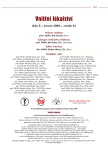Repolarization homogeneity in patients after acute myocardial infarction assessed from long-term 12-lead electrocardiographic recordings
Authors:
T. Novotný 1; I. Dohnalová 1; M. Šišáková 1; M. Poloczek 1; K. Hnátková 2; O. Toman 1; L. Dostálová 1; L. Maňoušková 1; A. Floriánová 1; P. Kala 1; J. Špinar 1; M. Malík 2
Authors‘ workplace:
Interní kardiologická klinika Lékařské fakulty MU a FN Brno, pracoviště Bohunice, přednosta prof. MUDr. Jindřich Špinar, CSc., FESC
1; Department of Cardiac and Vascular Sciences, St. George's University of London, Londýn, Spojené království
2
Published in:
Vnitř Lék 2008; 54(6): 618-622
Category:
Original Contributions
Overview
Background:
Abnormal heterogeneity of myocardial electrophysiologic processes increases the risk of malignant arrhythmias. The aim of the study was to assess changes of repolarization homogeneity in patients after acute myocardial infarction (MI) using morphological parameters obtained from long-term 12-lead electrocardiographic recordings.
Methods:
In the group of 200 patients (45 females, 155 males) a long-term (10 minutes supine) 12-lead electrocardiographic recording (SEER MC, GE Medical) was performed 48-72 hours after acute myocardial infarction. The following parameters were calculated using experimental software: total cosine R to T (TCRT) and T wave residuum (TWR). The results were correlated with Q wave evolution and left ventricular ejection fraction (LVEF).
Results:
Distinguishing the MI type (Q vs nonQ) the following values were obtained: TCRT: 0.17 ± 0.61 vs 0.16 ± 0.49, p = 0.52, absolute TWR: 21 247 ± 21 652 vs 25 715 ± 29 284, p = 0.3, relative TWR: 0.001 ± 0.002 vs 0.002 ± 0.001, p = 0.28. Stratification according to LVEF (≤ 40% vs < 40%) led to: TCRT: -0.03 ± 0.66 vs 0.25 ± 0.54, p = 0.01, absolute TWR: 29 689 ± 32 372 vs 21 259 ± 21 530, p = 0.14, relative TWR: 0.002 ± 0.004 vs 0.001 ± 0.002, p = 0.48.
Conclusion:
TCRT is a robust measurement of the spatial angle between the QRS complex and T wave loops which is related to LVEF. The results concerning TWR might indicate that this parameter is independent of LVEF, which needs to be confirmed in further analyses in a larger population.
Key words:
electrocardiogram - Holter - myocardial infarction - repolarization
Sources
1. Kuo CS, Munakata K, Reddy CP et al. Characteristics and possible mechanism of ventricular arrhythmia dependent on the dispersion of potential duration. Circulation 1983; 67: 1356-1367.
2. Novotný T, Šišáková M, Floriánová A et al. QT dynamicita v rizikové stratifikaci u pacientů po infarktu myokardu. Vnitř Lék 2007; 53: 964-967.
3. Acar B, Yi G, Hnatkova K et al. Spatial, temporal and wavefront direction characteristics of 12-lead T-wave morphology. Med Biol Eng Comput 1999; 37: 574-584.
4. Acar B, Koymen HL. SVD-based on-line exercise ECG signal orthogonalization. IEEE Trans Biomed Eng 1999; 26: 69-72.
5. Han J, Moe GK. Nonuniform recovery of excitability in ventricular muscle. Circ Res 1964; 14: 44.
6. Robert E, Aya AG, de la Coussaye JE et al. Dispersion-based reentry: mechanism of initiation of ventricular tachycardia in isolated rabbit hearts. Am J Physiol 1999; 276: H413-H423.
7. Malik M, Acar B, Gang Y et al. QT dispersion does not represent electrographic interlead heterogeneity of ventricular repolarization. J Cardiovasc Electrophysiol 2000; 11: 835-843.
8. Smetana P, Batchvarov VN, Hnátková K et al. Sex differences in repolarization homogeneity and its circadian pattern. Am J Physiol Heart Circ Physiol 2002; 282: H1889-H1897.
9. Smetana P, Batchvarov VN, Hnátková K et al. Ventricular gradient and nondipolar repolarization components increase at higher heart rate. Am J Physiol Heart Circ Physiol 2004; 286: H131-H136.
10. Zabel M, Acar B, Klingenheben T et al. Analysis of 12-lead T-wave morphology for risk stratification after myocardial infarction. Circulation 2000; 102: 1252-1257.
11. Batchvarov VN, Hnátková K, Ghuran A et al. Ventricular gradient as a risk factor in survivors of acute myocardial infarction. PACE 2003; 26: 373-376.
12. Perkiömäki JS, Hyytinen-Oinas M, Karsikas M et al. Usefulness of T-wave loop and QRS complex loop to predict mortality after acute myocardial infarction. Am J Cardiol 2006; 97: 353-360.
13. Zabel M, Malik M, Hnátková K et al. Analysis of T-wave morphology from the 12-lead electrocardiogram for prediction of long term prognosis in male US veterans. Circulation 2002; 105: 1066-1070.
Labels
Diabetology Endocrinology Internal medicineArticle was published in
Internal Medicine

2008 Issue 6
Most read in this issue
- Treatment of haemorrhage with transfusion preparations and blood derivatives
- Late recurrences of atrial fibrillation in patients after direct-current cardioversion
- Imaging of stenosis of ramus interventricularis anterior by computed tomography and selective coronarography
- Cancer personality: Current view and implications for future research
